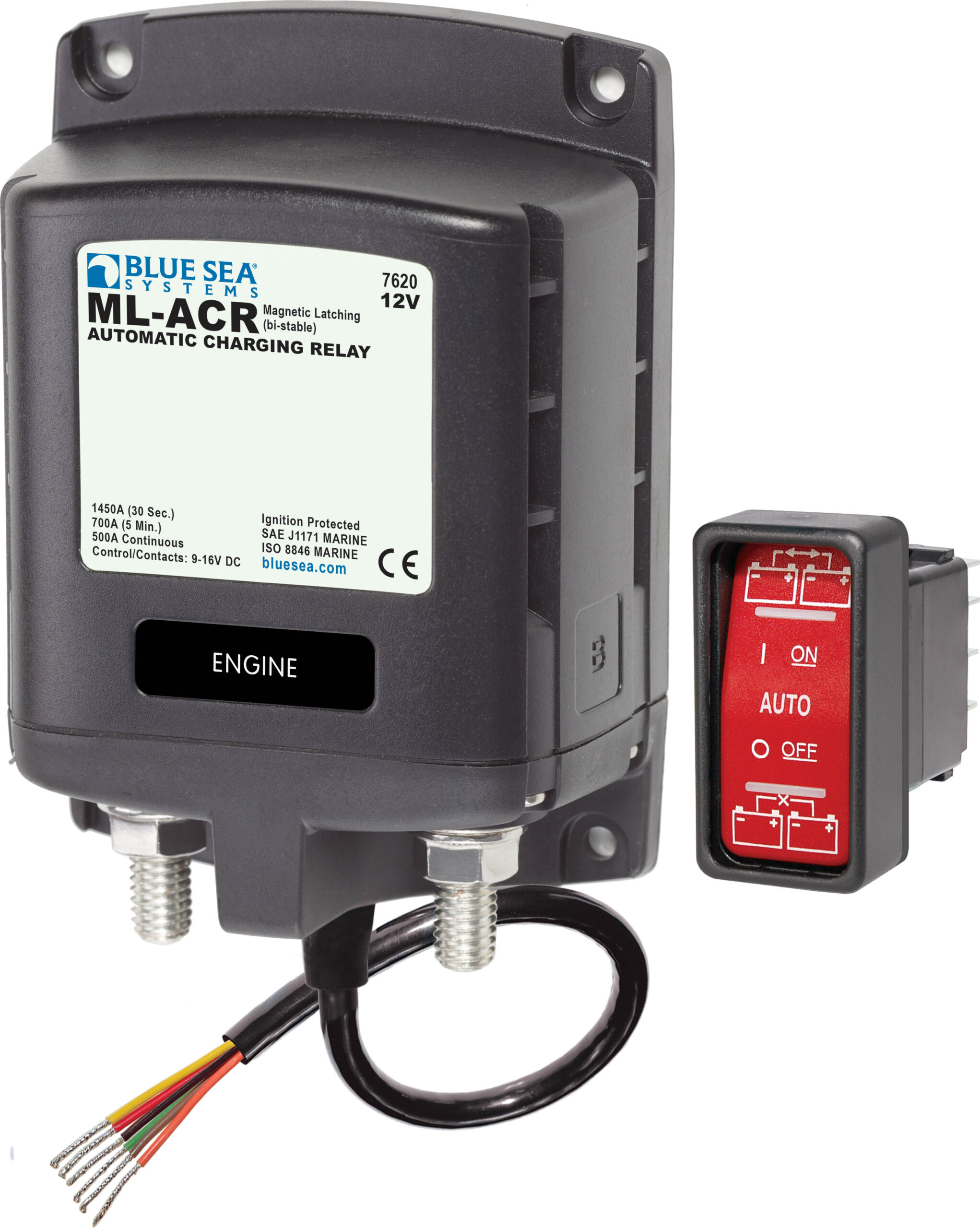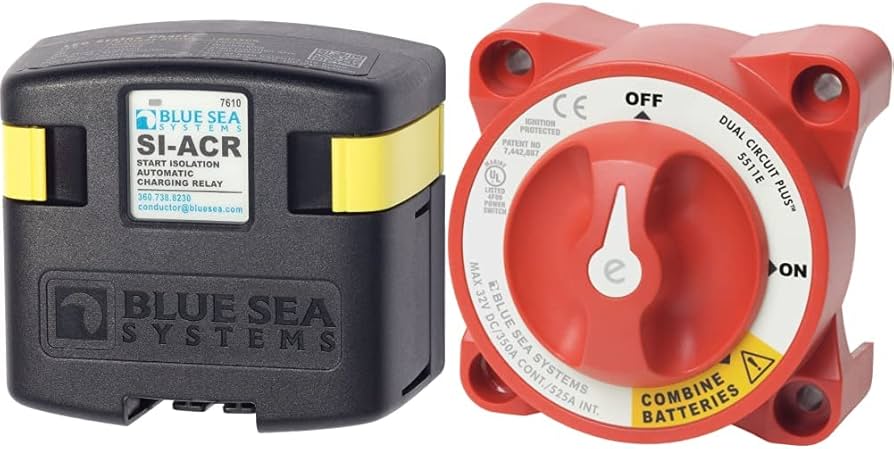What Is an Automatic Charging Relay?
An ACR, or Automatic Charging Relay, is simply a smart switch that connects (parallels) two battery banks when it senses charging voltage, and disconnects them when that voltage disappears. That’s it.
It works automatically, based on voltage levels, so there’s no need to manually flip switches or remember anything. When there’s a charging source (like an alternator or solar panel), the ACR joins the batteries. When the charging stops, it separates them.
The Old Way vs. the Smart Way
In the past, boat owners had to manually manage their battery charging. That usually meant setting the battery switch to “BOTH” or “ALL” while the engine was running. This worked well – until someone forgot to switch it back. If left in BOTH mode at anchor, both banks could drain, leaving you stuck with dead batteries.
The arrival of voltage-sensitive relays in the 1990s solved this issue. Unlike traditional diode isolators, which reduce voltage by about 0.6V, ACRs and similar relays connect batteries without that voltage drop. They automatically sense when to join or separate banks, taking human error out of the equation.
ACRs Today
Blue Sea Systems’ ACRs are some of the most popular on the market. Years ago, Blue Sea estimated that over 500,000 ACRs had been sold – and that number is likely much higher now. But they’re not the only ones making these devices. Companies like Yandina, Victron, BEP, Sterling Power, Smartgauge, and Balmar also offer similar products.
Though different models might vary slightly, they all do the same basic job: join batteries when voltage rises, and separate them when voltage drops.
Terms You Should Know
-
ACR (Automatic Charging Relay): Blue Sea Systems’ name for a voltage-triggered battery combiner.
-
VSR (Voltage Sensing Relay): A generic term for the same thing.
-
Combiner: Another generic term.
They all refer to the same class of device – a voltage-sensitive relay that automatically connects batteries when charging is happening.
Debunking Automatic Charging Relay Myths
Let’s clear up some common misconceptions:
-
ACRs don’t prioritize charging one battery before the other.
-
They don’t overcharge the starting battery.
-
They work fine with different types of batteries – as long as the charging voltages are similar.
-
You can charge the house bank first and the start battery will still charge.
-
An ACR won’t drain the start battery into the house bank.
-
And no, ACRs don’t cause massive in-rush currents that damage batteries.
These myths persist, but they’re simply not true. ACRs are quite smart and safe.
What’s Inside an ACR?
At its core, an ACR contains a relay – an electronic switch controlled by a coil and a logic board. The board measures voltage on each battery bank and decides when to energize the coil and close the switch (parallel the banks), or open it (separate them).
Inside, you’ll find:
-
Contacts that open or close to connect/disconnect batteries.
-
Copper buses leading to the external terminals.
-
A logic board that monitors voltage and controls the relay.
-
A relay coil that physically opens or closes the connection.
Well-built units last for years – even under constant use and harsh conditions. We’ve seen them run flawlessly for over a decade.
Where (and Where Not) to Install an ACR
An ACR should be connected between the positive terminals of two battery banks, with fuses placed near each terminal (within 7 inches). Do not install an ACR between a charging source (like an alternator or solar panel) and a battery. That’s a common mistake that can lead to equipment damage.
Also, avoid stacking multiple wires on a single terminal. Use a proper bus bar if needed. This ensures clean, reliable connections.
How an Automatic Charging Relay Decides When to Connect or Disconnect
To Connect (Combine):
-
If either battery reaches 13.0V for 90 seconds, or 13.6V for 30 seconds, the ACR closes and parallels the batteries.
To Disconnect (Uncombine):
-
If voltage drops below 12.75V for 30 seconds or 12.35V for 10 seconds, the ACR opens the circuit.
These delays help avoid “relay chatter” caused by brief voltage changes when a big load kicks in.
Start Isolation (SI)
Some ACRs have a feature called Start Isolation. It temporarily opens the relay while the engine is cranking, preventing the voltage drop from affecting sensitive electronics on the house bank. The SI wire should connect to the engine’s START position – not RUN.
Over- and Under-Voltage Lockout
To protect your batteries and equipment:
-
If voltage exceeds 16.0V, the ACR opens and locks out.
-
If it drops below 9.5V, the ACR also locks out until voltage rises again.
Why Charging the House Bank First Makes Sense
The house bank usually needs more charging than the start battery. Starting the engine only uses a tiny bit of energy – typically less than 0.5 amp-hours. That’s why many experienced cruisers wire charging sources (like alternators or solar) to the house bank first. Once the voltage rises, the ACR joins the start battery automatically.
Even from 50% charge, a good AGM battery can reach the ACR’s 13.0V trigger point in under two minutes when charging at a reasonable rate.
Wiring Tips for Cruising Boats
On boats with large house banks and smaller start banks, wire all charging sources – alternator, solar, wind, charger – directly to the house bank. This is more efficient and reduces the workload on the ACR relay.
Avoid feeding alternator output to the start battery unless your house and start banks are similar in size. Doing so means the ACR will have to carry the full alternator current, which is less ideal.
Fusing and Wire Sizing
The ACR wiring must be protected by fuses – not to protect the ACR, but to protect the wires. Match the fuse size to the wire and expected current. If using a 120A alternator, a 175A fuse and 1 AWG wire is a safer choice.
If your banks are already fused and use thick enough wires, you might not need extra fuses for the ACR.
Charge Sources and the ACR
An ACR works with any type of charge source – alternator, solar, wind, hydro, AC charger, even fuel cells. Because it works based on voltage sensing, it’s compatible with them all.
Unlike diode isolators, which cause voltage drops and don’t play well with smart regulators, an ACR has no such limitations. It’s a better all-around solution for modern systems.
Multi-Output Chargers and the ACR
A lot of boaters think their multi-output “smart” charger gives each battery its own unique charging profile. In reality, most of these chargers have just one power supply and one voltage regulator, with separate outputs protected by diodes or FETs to prevent backflow.
That means all batteries get the same voltage – just like they would with a single charger output and an ACR.
If you want fully independent charging profiles, you’ll need a charger with multiple regulators and power supplies, which is rare and expensive. Otherwise, using one output and an ACR works just as well.
When to Use an Automatic Charging Relay
Use an ACR when:
-
Both banks are the same chemistry (AGM, flooded, gel)
-
Or when they have similar charge voltages (within 0.1–0.2V)
Don’t use an ACR if:
-
You’re mixing chemistries with very different charging requirements (like GEL and TPPL AGM)
-
Voltage requirements differ by more than 0.3V
In those cases, a DC-to-DC charger is a better choice.
No, It Won’t Drain Your Start Battery
Some worry that an ACR will let the house bank drain the start battery. But this is false. The ACR disconnects at 12.8V – basically full charge – so there’s no meaningful energy transferred. By the time the voltage drops enough to cause concern, the ACR has already disconnected the banks.
No, It Won’t Blow Up Your Battery
Worried about a “massive in-rush current” when the ACR connects? Don’t be. Tests show that even at a significant state of discharge, the peak current between banks lasts less than 0.2 seconds and is well within safe limits.
Most batteries can handle in-rush currents many times higher than what the ACR can deliver during combining. It’s not dangerous.
Choosing the Right ACR
-
Fully automatic
-
Handles up to 120A continuously
-
Great for most boats
-
Handles up to 500A
-
Can be switched manually or run fully automatic
-
Great for windlass or bow thruster setups where you want more flexibility
An ACR is a simple, effective, and reliable tool for managing multiple battery banks. It eliminates human error, works with all types of charging sources, and requires minimal maintenance. For most boaters – especially cruisers with large house banks – it’s a smart addition to the electrical system.




